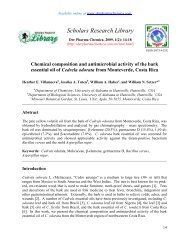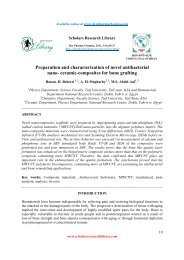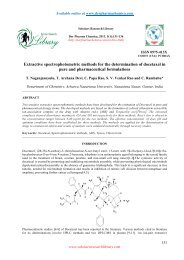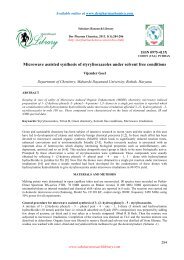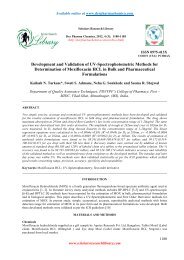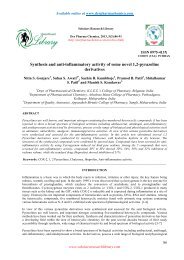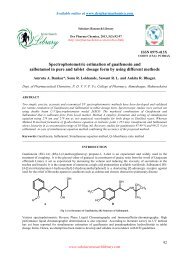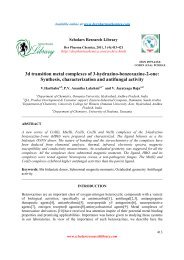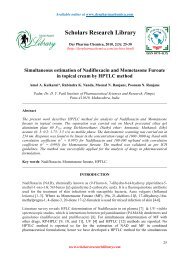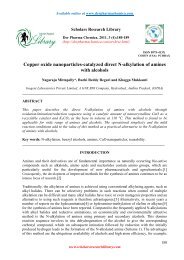Synthesis and evaluation of some novel thiomers as mucoadhesive ...
Synthesis and evaluation of some novel thiomers as mucoadhesive ...
Synthesis and evaluation of some novel thiomers as mucoadhesive ...
Create successful ePaper yourself
Turn your PDF publications into a flip-book with our unique Google optimized e-Paper software.
Rajesh J. Oswal et al Der Pharma Chemica, 2012, 4 (4):1385-1396<br />
_____________________________________________________________________________<br />
In recent years the interest in bioadhesion h<strong>as</strong> been inspired by the development <strong>of</strong> <strong>novel</strong> bioadhesive polymers for<br />
mucosal delivery. Bioadhesive, or more precise <strong>mucoadhesive</strong> drug delivery systems are aimed to adhere to various<br />
mucosal tissues. All traditionally used <strong>mucoadhesive</strong> polymers, e.g. poly(acrylates) or chitosan, are b<strong>as</strong>ed on the<br />
formation <strong>of</strong> noncovalent bonds such <strong>as</strong> hydrogen bonds <strong>and</strong> ionic interactions with the mucus layer. These<br />
polymers provide only a weak adhesion being in many c<strong>as</strong>es insufficient to guarantee the localisation <strong>of</strong> a drug at a<br />
given target site. According to this, various attempts have been undertaken to improve the <strong>mucoadhesive</strong> properties<br />
<strong>of</strong> polymers. A promising new approach w<strong>as</strong> the generation <strong>of</strong> thiolated polymers—or the so-called <strong>thiomers</strong>. Due<br />
to immobilized thiol groups these polymers are capable <strong>of</strong> forming covalent bonds with the mucus layer covering<br />
mucosal tissues, subsequently leading to improved <strong>mucoadhesive</strong> properties [2-3]. The responsible mechanism for<br />
this effect is b<strong>as</strong>ed on thiol/disulfide exchange reactions between the thiol groups <strong>of</strong> the polymer <strong>and</strong> the cysteinerich<br />
subdomains <strong>of</strong> mucin glycoproteins [4]. First success w<strong>as</strong> achieved with polycarbophil–cysteine <strong>and</strong> chitosan–<br />
thioglycolic acid conjugates displaying a 2.75- <strong>and</strong> 10.3-fold, respectively, higher mucoadhesion on freshly excised<br />
porcine intestinal mucosa than the corresponding unmodified polymers. Due to these strongly improved<br />
<strong>mucoadhesive</strong> properties, <strong>thiomers</strong> seem to be advantageous over so far used polymers. The better adhesion to<br />
mucosal tissues should provide the localisation <strong>of</strong> the delivery system in specified regions, like the buccal, n<strong>as</strong>al or<br />
vaginal epithelium. Furthermore, a comparatively longer residence time at the site <strong>of</strong> drug absorption can be<br />
achieved. A limiting factor thereby seems to be the rapid turnover <strong>of</strong> the mucus. But the intensified contact with the<br />
mucosal absorption membranes provided by <strong>thiomers</strong> should additionally guarantee an incre<strong>as</strong>ed drug concentration<br />
gradient representing the driving force for a p<strong>as</strong>sive drug uptake. In order to make further progress in investigating<br />
the potential <strong>of</strong> thiolated polymers, it w<strong>as</strong> the aim <strong>of</strong> this study to evaluate the properties <strong>of</strong> two recently generated<br />
<strong>thiomers</strong>: carboxymethyl starch –cysteine <strong>and</strong> carboxymethyl guar gum –cysteine in a common dosage form [5].<br />
Among delivery systems tablets provide an accurate dosage <strong>and</strong> are e<strong>as</strong>y to manufacture. Accordingly, the features<br />
<strong>of</strong> tablets b<strong>as</strong>ed on CMS–cysteine <strong>and</strong> CMG–cysteine conjugates were evaluated focusing on swelling <strong>and</strong><br />
disintegration behaviour <strong>as</strong> well <strong>as</strong> on mucoadhesion. Obtained results should contribute to a better underst<strong>and</strong>ing <strong>of</strong><br />
the function <strong>of</strong> <strong>thiomers</strong> in delivery systems.<br />
MATERIALS AND METHODS<br />
Materials<br />
The gift sample <strong>of</strong> Guar gum w<strong>as</strong> obtained from Premchem Gums Private Limited, Mumbai, India. Metformin<br />
Hydrochloride w<strong>as</strong> received from Emcure Pharmaceuticals, Pune, India. All the other chemicals were <strong>of</strong> analytical<br />
grade <strong>and</strong> purch<strong>as</strong>ed locally.<br />
<strong>Synthesis</strong> <strong>of</strong> Carboxymethyl Guar Gum (CMG) <strong>and</strong> Carboxymethyl Starch (CMS)<br />
For a typical synthesis <strong>of</strong> CMG / CMS, 5 g (8.69 mmole; 19.92 mmole) <strong>of</strong> guar gum / starch w<strong>as</strong> suspended in 150<br />
ml isopropanol. The reaction mixture w<strong>as</strong> vigorously stirred at room temperature for 1 h after addition <strong>of</strong> 10 ml <strong>of</strong><br />
15% aqueous NaOH solution (1.5 g, 37.8 mmole). Then 4.39 g (37.8 mmole) SMCA w<strong>as</strong> added <strong>and</strong> the temperature<br />
<strong>of</strong> the reaction bath w<strong>as</strong> raised to 55 0 C. The etherification w<strong>as</strong> performed for 3 hrs. The product w<strong>as</strong> filtered <strong>of</strong>f,<br />
suspended in 80% (v/v) aqueous methanol, neutralized with dilute acetic acid, <strong>and</strong> w<strong>as</strong>hed five times with 100 ml<br />
ethanol. The product w<strong>as</strong> dried in oven [6-10].<br />
<strong>Synthesis</strong> <strong>of</strong> thiolated polymers<br />
5 g <strong>of</strong> CMS/CMG w<strong>as</strong> hydrated in 100 ml <strong>of</strong> distilled water to form a homogeneous solution. The carboxylic acid<br />
groups <strong>of</strong> the polymer were activated by the addition <strong>of</strong> 1-ethyl-3-(3-dimethylaminopropyl) carbodiimide<br />
hydrochloride (EDAC) to a final concentration <strong>of</strong> 50 mM. The reaction w<strong>as</strong> allowed to proceed for about 45 min.<br />
The sulphur containing amino acid cysteine w<strong>as</strong> added to a weight-ratio <strong>of</strong> 1:2 (polymer: amino acid) <strong>and</strong> the pH<br />
w<strong>as</strong> adjusted to around 4.0 using 1M HCl solution. The reaction mixture w<strong>as</strong> incubated for 2 hrs. under stirring at<br />
room temperature. The pH w<strong>as</strong> raised to 6.0 using 1 M NaOH solution <strong>and</strong> the reaction proceeded for an additional<br />
1 hr. The resulting thiomer conjugated w<strong>as</strong> isolated by dialyzing against 1 mM HCl aqueous solution at room<br />
temperature, followed by 2 cycles <strong>of</strong> dialysis against 1% NaCl in 1 mM HCl aqueous solution <strong>and</strong> then thoroughly<br />
against 1 mM HCl aqueous solution. Samples were lyophilized by drying frozen aqueous polymer solutions at-40°C<br />
[11-14].<br />
www.scholarsresearchlibrary.com<br />
1386



